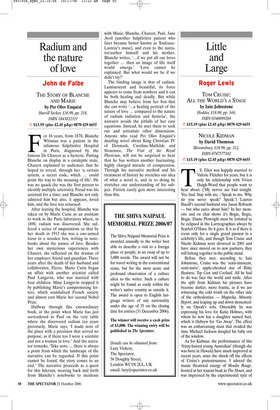Radium and the nature of love
John de Falbe
THE STORY OF BLANCHE AND MARIE by Per Olov Enquist Harvill Secker, £16.99, pp. 218, ISBN 1843432331 ✆ £13.59 (plus £2.45 p&p) 0870 429 6655 For 16 years, from 1878, Blanche Wittman was a patient in the infamous Salpêtrière Hospital in Paris, diagnosed by the famous Dr Charcot as a hysteric. Putting Blanche on display in a cataleptic state, Charcot explained to audiences that he hoped to reveal, through her ‘a certain system, a secret code, which ... could point the way to the meaning of life’. He was no quack (he was the first person to identify multiple sclerosis); Freud was his assistant for a time; and Blanche not only admired him but also, it appears, loved him, and the love was returned.
After leaving the hospital, Blanche was taken on by Marie Curie as an assistant to work in the Paris laboratory where, in 1898, radium was discovered. She suffered a series of amputations so that by her death in 1913 she was a one-armed torso in a wooden box, writing in notebooks about the nature of love. Besides her own mysterious experiences with Charcot, she reflected on the dramas of her employer, friend and guardian. Three years after the death of her husband and collaborator, Pierre, Marie Curie began an affair with another scientist called Paul Langevin, who was married with four children. Mme Langevin stopped it by publishing Marie’s compromising letters, which scandalised French society and almost cost Marie her second Nobel Prize.
Halfway through this extraordinary book, at the point when Marie has just surrendered to Paul on the very table where she discovered radium ten years previously, Marie says, ‘I made note of the place with a precision that served no purpose, as if there too I were a scientist and not a woman in love.’ And the narrator remarks, ‘Take note: ... there is always a point from which the landscape of the narrative can be regarded. If this point cannot be found, the story comes to an end.’ The narrative proceeds as a quest for this fulcrum, weaving back and forth from Blanche’s notebooks to incidents with Marie, Blanche, Charcot, Paul, Jane Avril (another Salpêtrière patient who later became better known as ToulouseLautrec’s muse), and even to the narrator/author himself and his mother. Blanche writes, ‘...if we put all our loves together ... then an image of life itself would emerge.’ ‘Love cannot be explained. But what would we be if we didn’t try?’ The binding image is that of radium. Luminescent and beautiful, its force appears to come from nowhere and it can be both healing and deadly. But while Blanche may believe from her box that she can write ‘...a healing portrait of the nature of love ... compared to the nature of radium radiation and hysteria’, the narrator avoids the pitfalls of her easy equations. Instead, he uses them to seek out and articulate other dimensions. Anyone who read Per Olov Enquist’s dazzling novel about King Christian IV of Denmark, Caroline-Mathilde and Struensee, The Visit of the Royal Physician, will not be surprised to hear that he has written another fascinating, highly charged miracle of compression. Through his narrative method and his treatment of history he stretches our idea of what a novel is, and in so doing he stretches our understanding of his subject. Fiction rarely gets more interesting than this.


































































































 Previous page
Previous page